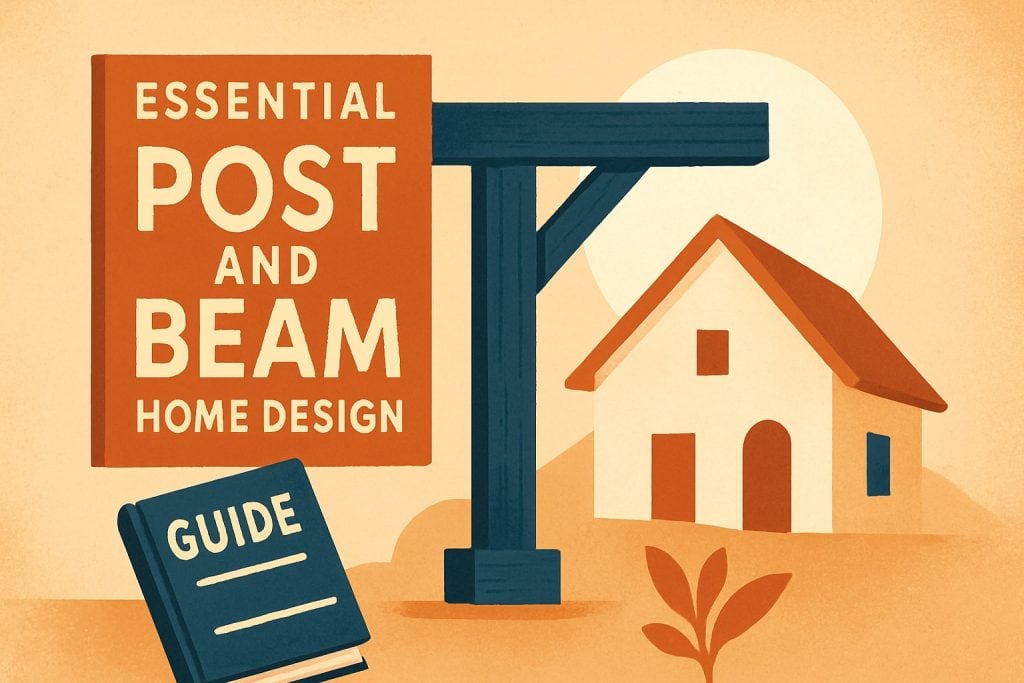In 2025, there is a remarkable resurgence in post and beam home design as homeowners seek both timeless beauty and structural flexibility in their living spaces. This comprehensive guide will introduce you to the world of post and beam home design, exploring its core principles, distinctive benefits, and why it stands out in today’s housing market. Whether you are drawn to its exposed timber craftsmanship or the versatility it offers for modern living, you will gain up-to-date insights and practical advice to help you make informed decisions. Discover the fundamentals, design trends, innovative features, planning steps, cost factors, and sustainable practices that define post and beam home design today. Ready to create a truly unique home? Let’s get started.
Understanding Post and Beam Home Design: Fundamentals and History
Post and beam home design has captivated homeowners for centuries, thanks to its unique blend of structural integrity and visual charm. To truly appreciate why this method remains relevant in 2025, it is essential to understand its construction principles, origins, and architectural variations.
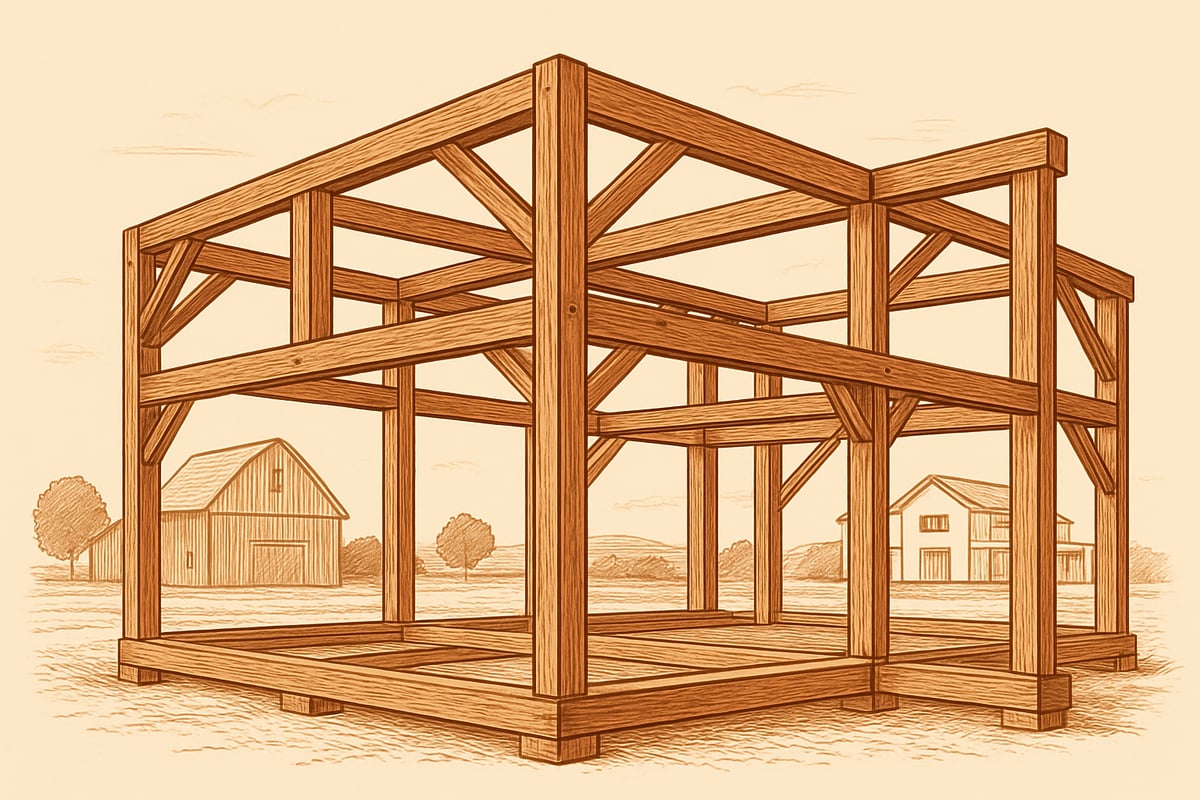
Defining Post and Beam Construction
At its core, post and beam home design uses a system of upright posts supporting horizontal beams to create a robust structural skeleton. This method stands apart from timber frame and conventional framing by emphasising fewer, larger timbers and highly visible joinery.
Traditional materials include:
- Oak
- Douglas fir
- Other durable hardwoods
A hallmark of post and beam home design is the exposed joinery, often crafted with mortise and tenon connections. This approach not only ensures longevity but also delivers exceptional resilience. For a deeper look at the fundamentals, see the Understanding Framed Home Construction guide.
Historical Evolution and Global Influence
The origins of post and beam home design can be traced back to medieval Europe and ancient Asia. Craftspeople honed these techniques to build homes, barns, and temples that could withstand the test of time.
Over centuries, post and beam home design evolved, influencing British cottages, North American farmhouses, and Japanese minka dwellings. Its enduring popularity lies in the method's adaptability, shaping both rural retreats and contemporary homes across the globe.
Key Components and Structural Principles
The anatomy of a post and beam home design includes several core elements:
- Upright posts
- Horizontal beams
- Diagonal braces
- Specialised connectors
This structure efficiently distributes loads, allowing for open-plan interiors and flexible layouts. Mortise and tenon joinery is traditional, but some modern builds use metal fasteners for added strength. Post and beam home design integrates well with current building codes, offering both heritage and compliance.
Advantages Over Other Building Methods
Choosing post and beam home design presents several benefits over conventional construction. Open interiors and the option for expansive windows create light-filled, airy spaces. The structural strength of large timbers provides excellent earthquake resistance and long-term durability.
Aesthetic appeal is another draw, with exposed timber bringing warmth and character. The reduced need for interior load-bearing walls allows homeowners to customise layouts with ease, making post and beam home design a top choice for creative living.
Popular Styles and Architectural Variations
Over time, post and beam home design has inspired a range of architectural styles:
- Classic barn-inspired homes
- Sleek, contemporary builds
- Hybrid designs blending timber with glass or steel
Iconic examples can be found throughout the UK and internationally, each reflecting the timeless beauty and adaptability of this construction method.
The Benefits of Post and Beam Homes in 2025
Choosing post and beam home design in 2025 brings a wealth of advantages for homeowners seeking a distinctive blend of tradition and innovation. From sustainability to long term value, these homes offer features that meet the demands of modern living while retaining timeless charm.
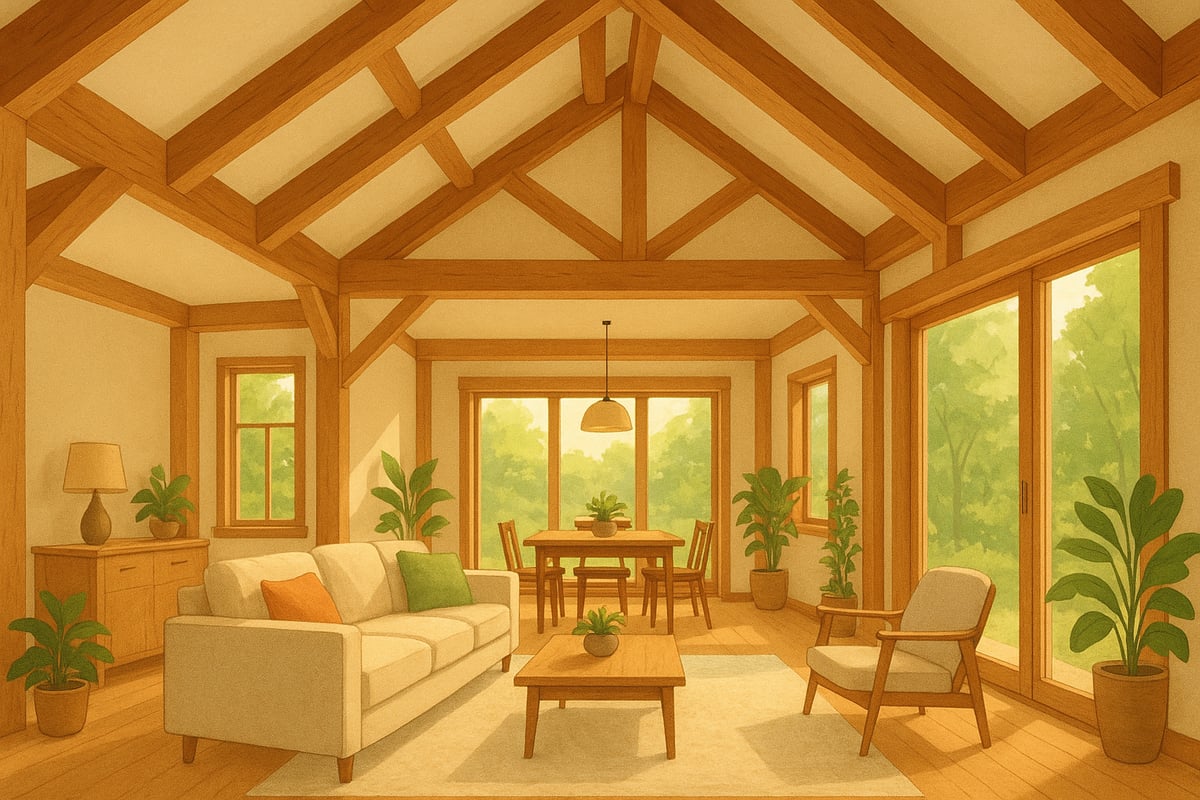
Energy Efficiency and Sustainability
One of the standout benefits of post and beam home design is its inherent energy efficiency. Timber naturally insulates, helping regulate indoor temperatures and reducing energy consumption. These homes are highly compatible with eco friendly technologies such as solar panels, heat pumps, and rainwater harvesting.
When responsibly sourced, timber offers a lower carbon footprint compared to traditional steel or concrete structures. Homeowners can further reduce environmental impact by selecting FSC certified or reclaimed wood. In 2025, the use of sustainable and eco friendly materials continues to shape the industry, making post and beam home design a forward thinking choice.
Design Flexibility and Customisation
Post and beam home design is renowned for its adaptable layouts, which empower homeowners to create open plan living spaces, mezzanines, or dramatic vaulted ceilings. This flexibility allows for seamless integration of modern amenities, including smart home systems, underfloor heating, and bespoke lighting schemes.
The structural system supports large windows and sliding doors, blurring the boundaries between indoor and outdoor spaces. Whether you prefer a rustic barn aesthetic or a sleek contemporary look, post and beam home design can be tailored to your unique vision, ensuring your home reflects your personality and lifestyle.
Durability and Low Maintenance
A key strength of post and beam home design lies in its long lasting durability. Hardwoods such as oak and Douglas fir are naturally robust and, when properly treated, resist pests and decay. With minimal upkeep, these structures can stand strong for generations, often outlasting conventional builds.
Homeowners benefit from reduced maintenance costs, as the exposed timber frame requires only occasional inspections and treatments. Investing in post and beam home design means choosing a structure built to endure both time and the elements, ensuring peace of mind for years to come.
Health and Wellbeing
Living in a post and beam home design can have a positive impact on your health and wellbeing. Timber’s natural properties promote improved indoor air quality, while non toxic finishes and adhesives minimise exposure to harmful chemicals.
Biophilic design elements, such as visible wood grain and connection to outdoor views, support stress reduction and mental wellness. The sense of warmth and authenticity found in post and beam home design makes these homes not just beautiful, but nurturing environments for families and individuals alike.
Value and Resale Potential
Post and beam home design stands out in the property market for its unique character and architectural appeal. There is growing demand among buyers for homes that offer both individuality and craftsmanship, leading to strong resale values for bespoke timber properties.
Recent UK property sales highlight the resilience of this market segment. The combination of timeless style, sustainability, and high build quality ensures that post and beam home design remains a sound investment, attracting discerning buyers and retaining value over time.
Architectural Beauty and Timelessness
One of the most celebrated features of post and beam home design is its visual impact. Exposed beams serve as striking focal points, creating a sense of grandeur and authenticity in any room.
These homes effortlessly blend traditional joinery with contemporary finishes, producing spaces that are elegant, inviting, and full of character. Award winning post and beam homes demonstrate the enduring appeal of this architectural method, proving that true beauty transcends trends.
Trends and Innovations in Post and Beam Home Design for 2025
The world of post and beam home design is evolving rapidly in 2025, blending centuries-old craftsmanship with cutting-edge technology and eco-conscious thinking. Homeowners are seeking spaces that offer comfort, efficiency, and a seamless link to nature. Let us explore the latest trends and innovations shaping post and beam home design, from smart home integration to regulatory changes.
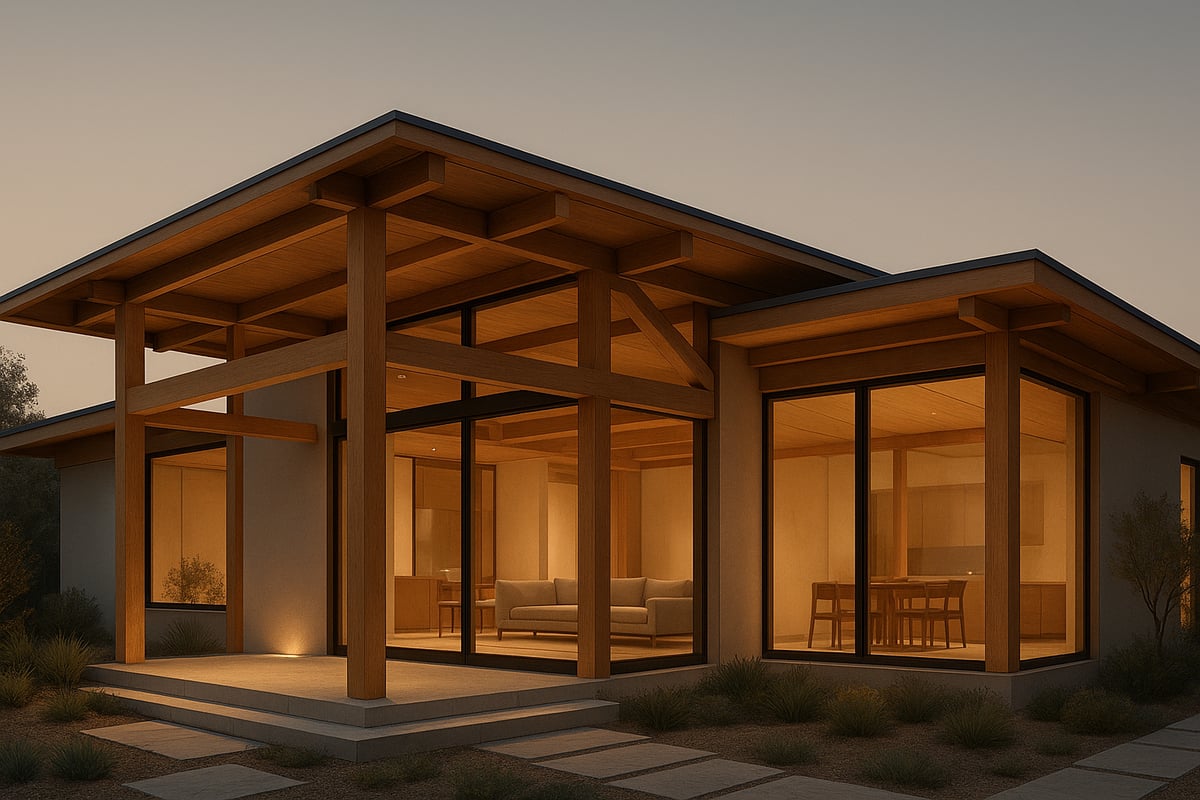
Smart Home Integration and Modern Comforts
In 2025, smart technology is integral to post and beam home design. Homeowners are incorporating intelligent lighting, zoned heating, and advanced security systems for greater control and convenience. Discreetly hidden wiring preserves the clean lines of exposed timber, ensuring technology does not detract from architectural beauty.
Examples include voice-activated lighting that highlights timber beams and underfloor heating managed remotely. These innovations allow post and beam home design to deliver both traditional appeal and modern comfort. The result is a living space that is responsive, energy-efficient, and uniquely personal.
Sustainable Materials and Green Building Practices
Sustainability remains central to post and beam home design. Engineered timber, such as cross-laminated timber (CLT), is increasingly popular for its strength and eco-friendly credentials. Many projects meet or exceed passive house standards, using energy modelling to reduce consumption.
Recycled and reclaimed materials are frequently chosen, supporting a lower-carbon footprint. Builders prioritise timber certified by FSC or PEFC, ensuring responsible sourcing as part of post and beam home design. These choices reflect a growing commitment to long-term environmental stewardship.
Architectural Trends: Open Plans, Minimalism, and Hybrid Styles
Open-plan living is a defining feature of post and beam home design in 2025. Expansive layouts, minimal internal walls, and vaulted ceilings create a sense of space and airiness. Minimalist interiors, with natural finishes, let the timber structure shine as a focal point.
Hybrid styles are gaining popularity, combining timber with steel or glass for dramatic effect. For further inspiration on combining post and beam with other materials, see Timber Frame Hybrid House Insights. This approach allows post and beam home design to remain fresh and versatile, accommodating a variety of aesthetic preferences.
Prefabrication and Modular Construction
Prefabrication is transforming how post and beam home design projects are delivered. Off-site fabrication ensures precision and reduces construction time, resulting in higher build quality. Modular post and beam kits are now available for self-builders, making custom homes more accessible.
This shift streamlines the construction process, helps manage costs, and minimises waste. Prefabrication also supports flexibility, allowing homeowners to expand or adapt their post and beam home design as needs evolve.
Outdoor Living and Biophilic Design
Connecting indoor and outdoor spaces is a hallmark of post and beam home design. Architectural features such as large glazed doors, verandas, and garden rooms maximise natural light and views. Biophilic design principles foster a sense of wellbeing by integrating greenery, timber, and natural stone.
Homeowners are creating outdoor living areas that flow seamlessly from interior spaces, encouraging year-round enjoyment. This trend ensures that post and beam home design not only looks beautiful but also enhances daily living.
Regulatory and Planning Developments
In 2025, updates to UK building codes are shaping post and beam home design. Regulations now emphasise fire safety, insulation standards, and structural integrity. Compliance is essential, influencing material choices and construction methods.
Navigating planning permissions and building regulations early in the process helps ensure a smooth build. By staying informed, homeowners and designers can create post and beam home design projects that are both innovative and fully compliant with current standards.
Step-by-Step Guide: Planning and Building a Post and Beam Home
Embarking on a post and beam home design journey is both exciting and rewarding. Careful planning at each stage ensures your vision becomes a reality, tailored to your lifestyle and tastes. This guide breaks down the process into clear, manageable steps so you can confidently approach your dream build.

Step 1: Defining Your Vision and Requirements
Begin your post and beam home design by outlining what you truly want from your new space. Consider your daily routines, the number of bedrooms and bathrooms, and any must-have features such as open-plan kitchens or home offices.
Browse architectural magazines, online galleries, and completed homes for inspiration. Make a list of your top priorities, including energy efficiency, sustainability, and preferred architectural style.
Having a clear vision ensures that every decision, from layout to materials, supports your ultimate goals.
Step 2: Selecting the Right Site
Choosing the perfect plot is crucial for successful post and beam home design. Evaluate orientation for natural light, ease of access, ground stability, and the potential for scenic views.
Check local planning guidelines and restrictions before committing. Some rural or protected areas may have specific requirements for timber builds.
Ideal sites often offer a balance of privacy, accessibility, and a strong connection to the surrounding landscape. Take your time to find a location that complements your ambitions.
Step 3: Designing Your Home Layout and Features
Work with an architect experienced in post and beam home design to translate your ideas into practical layouts. Open-plan living, double-height ceilings, and feature windows are popular choices that accentuate the structural beauty of exposed beams.
Balance communal and private spaces, ensuring the design meets your household’s needs. Consider adding mezzanines, reading nooks, or integrated storage solutions.
Early collaboration with professionals streamlines the process and helps avoid costly redesigns later.
Step 4: Choosing Materials and Structural Details
The structural integrity and aesthetics of your post and beam home design rely heavily on material selection. Oak, Douglas fir, and larch are favoured for their strength and visual appeal.
Prioritise sustainably sourced timber, such as FSC or PEFC-certified wood, to minimise your environmental footprint. Decide on exposed joinery styles, finishes, and insulation methods that align with your vision.
Consult with specialists to ensure your chosen materials meet both design and regulatory standards.
Step 5: Budgeting and Cost Planning
A realistic budget is essential for a successful post and beam home design. Itemise all anticipated costs, including design fees, planning permissions, timber, labour, and interior finishes.
Research average build costs per square metre in your region for 2025, and factor in a contingency for unexpected expenses. Compare the costs of different timber species and structural complexities.
Regularly review your budget throughout the project to stay on track and avoid overspending.
Step 6: Finding and Working with Specialists
Engage a team of professionals skilled in post and beam home design. Look for experienced builders, architects, and engineers with a proven track record in similar projects.
Request references, visit completed homes, and ensure clear communication about your expectations. Collaboration among your team is vital for smooth progress and maintaining quality standards.
A strong partnership with your specialists results in a home that reflects your vision and stands the test of time.
Step 7: Construction Process and Timeline
Understanding the construction phases is key to managing your post and beam home design project. The journey typically involves foundation work, frame erection, enclosing the structure, and internal fit-out.
Timelines vary depending on site conditions and complexity, but off-site prefabrication can speed up the process. Quality control and site safety should be priorities at every stage.
For a detailed breakdown of each construction step, see the Frame Home Construction Process guide, which offers valuable insights for first-time and seasoned self-builders alike.
Step 8: Interior Design and Final Touches
The final stage of post and beam home design is where your style truly comes to life. Select finishes, lighting, and furnishings that highlight the natural timber and architectural features.
Blend traditional elements, such as exposed beams and rustic flooring, with contemporary décor for a timeless yet modern feel.
Take inspiration from completed homes to create spaces that are both functional and welcoming, ensuring your new home is a true reflection of your personality.
Cost Considerations and Financing Your Post and Beam Home
Understanding the financial side of post and beam home design is essential for a successful self-build project. With unique materials and construction techniques, these homes require careful budgeting and planning. Let us explore the real costs, financing solutions, and strategies to keep your dream home on track and within budget.
Typical Costs and Budget Breakdown
The cost of a post and beam home design in 2025 typically ranges from £2,200 to £3,800 per square metre, depending on timber species, design complexity, and location. Oak and Douglas fir are premium choices, often commanding higher prices due to their strength and visual appeal. Labour, site conditions, and the inclusion of complex architectural features can also influence the final budget.
Compared to conventional builds, post and beam homes offer superior customisation and durability but may entail higher upfront costs. However, the long-term value and low maintenance often justify the investment. For a detailed comparison between timber frame, log, and post and beam structures, consult the Timber Frame and Log Homes Guide.
It is wise to allocate a contingency fund, typically 10 to 15 percent of your total budget, to manage unexpected expenses during your post and beam home design project.
Financing Options and Grants
Financing a post and beam home design in the UK usually involves a self-build mortgage, which releases funds in stages as your project progresses. Lenders may require detailed plans, planning permission, and proof of costings before approval. Consider approaching specialist lenders who understand the unique nature of post and beam construction.
Government incentives increasingly support sustainable building. Grants may be available for using certified timber, renewable energy systems, and eco-friendly features. Choosing responsibly sourced wood, as detailed in Green Building and Wood, can improve eligibility for certain schemes and reduce your overall carbon footprint.
Carefully review eligibility criteria and application deadlines to maximise your funding options.
Managing Costs and Avoiding Pitfalls
Effective cost management is crucial for a successful post and beam home design project. Start with a detailed breakdown that covers design, materials, labour, and permits. Prioritise essential features and consider value engineering options to keep costs in check without sacrificing quality.
Common budgeting mistakes include underestimating site preparation, neglecting VAT implications, or skipping professional project management. Regularly review your budget and timeline, keeping all stakeholders informed to avoid delays or overruns.
Engaging experienced professionals early can prevent costly errors and ensure your build stays on track.
Insurance and Long-Term Value
Insurance is vital during both construction and occupancy. Self-build insurance covers site risks, while completed home insurance should reflect the unique features of post and beam home design.
These homes maintain strong resale value, with bespoke timber properties continuing to attract discerning buyers in the UK market.
Sustainability and Environmental Impact of Post and Beam Homes
Sustainability is at the heart of post and beam home design, making it an attractive choice for eco-conscious homeowners. The approach not only prioritises renewable materials but also encourages efficient building methods and long-term environmental responsibility. Let us explore how post and beam home design contributes to a greener future through responsible timber sourcing, energy efficiency, waste reduction, and adaptable architecture.
Timber Sourcing and Certification
The foundation of sustainable post and beam home design lies in the careful selection of timber. Responsible builders prioritise wood from forests certified by schemes such as the Forest Stewardship Council (FSC) or the Programme for the Endorsement of Forest Certification (PEFC). These certifications guarantee that timber is harvested in ways that protect biodiversity and support local communities.
Using reclaimed or locally sourced wood further reduces environmental impact. This approach minimises transportation emissions and promotes circular economy principles. By choosing certified or reclaimed timber, homeowners support forest conservation and contribute to carbon sequestration, as timber stores carbon throughout its lifespan. These choices ensure that post and beam home design remains both beautiful and responsible.
Energy Performance and Eco-Friendly Features
Modern post and beam home design excels in energy performance. The natural insulating properties of timber help regulate indoor temperatures, reducing reliance on artificial heating and cooling. Many homes are now designed with passive solar principles, orienting windows and living areas to capture sunlight and promote natural ventilation.
High-performance insulation and airtight construction are standard in contemporary builds, often paired with renewable energy systems such as solar panels or heat pumps. These features dramatically lower energy consumption and operating costs. For further insights into green building benefits, see Post Frame Construction Sustainability, which highlights the efficiency and environmental advantages of timber-based construction methods.
Waste Reduction and Lifecycle Considerations
Post and beam home design typically generates less construction waste than conventional builds. Prefabrication of frame elements off-site allows for precise measurements, reducing material offcuts and errors. Timber’s durability means structures last for generations, minimising the need for frequent repairs or replacements.
At the end of a building’s life, timber frames can be dismantled and reused or recycled, unlike steel or concrete, which are more challenging to process. Lifecycle analysis consistently shows that post and beam home design has a smaller environmental footprint due to its renewable resource base and end-of-life recyclability. This approach aligns with the principles of sustainable construction and long-term resource stewardship.
Future-Proofing and Adaptability
Adaptability is a key strength of post and beam home design. Open-plan layouts and modular construction allow for easy reconfiguration as family needs change. Homes can be designed to withstand extreme weather, offering resilience in the face of climate change.
Many projects now integrate biophilic principles, connecting occupants to nature through abundant daylight, garden access, and natural materials. This not only enhances wellbeing but also prepares homes for evolving environmental standards. Examples across the UK demonstrate how post and beam home design delivers future-ready, sustainable living spaces that can adapt to new technologies and lifestyles.
As you’ve discovered, post and beam home design is where timeless craftsmanship meets innovation, offering you the freedom to shape every detail to your lifestyle and vision. If you’re inspired by the beauty, sustainability, and versatility outlined here, why not take the next step toward making your dream home a reality? At Acorn to Oak Framing, we specialise in bespoke timber frame projects, guiding you from initial ideas through to completion with dedication and expertise. Let’s explore how we can bring your unique home to life—start your journey today and BUILD NOW.
